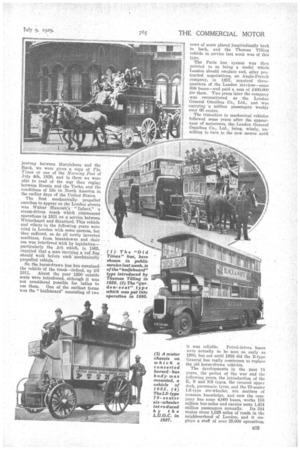The Centenary of
Page 110

Page 111

If you've noticed an error in this article please click here to report it so we can fix it.
London's Bus Services
TANY Londoners 'TIM_ member the pairhorsed buses of the London General Omnibus Co., Ltd., which afforded the principal means for short-distance travel in the centre of the Metropolis towards the close of last century and during the reign of King Edward, and the sight ofone of these very conveyances, with driver and conductor wearing their old-time dresses, plying for hire last week on the route inaugurated in 1880, awakened many a happy and melIow memory.
The 1880 garden-seat bus, so familiar until 1911, was the least venerable of the three old-timers which the London General Omnibus Co., Ltd., put back into service on July 3rd, 4th, and 5th in commemoration of the centenary of the first London "omnibus." There was the Knifeboard bus which Thomas Tilling operated between Peckham and Oxford Circus so long ago as 1850.
We had the opportunity last week of mounting a replica of the first of all London buses, the long-bodied Shillibeer of 1829, and taking a ride in it from Marylebone along what used to be called the New Road to King's Cross, Moor
gate and the Bank of England. It proved a fine-looking coach in its way, not so uncomfortable as we might have expected, and, withal, not much slower in its progress than the present-day vehicle in the congested areas of the City. Three horses the old Shillibeer bad, and a long enclosed body with entrance door and steps at the rear
E52 and padded seats extending along the sides and the front end.
The idea of the omnibus was not conceived in London. There had been a public-service coach working on short routes in Paris so far back as 1819, and the adoption of the word " omnibus " very probably had its origin in Nantes, where a carriage called " l'Omnibus " was put into service in 1827. It was in constructing some omnibuses for service in Paris in 1825 that Shillibeer conceived the idea of putting the same type of vehicle on the London streets, and this he did four years later. Like the pioneer of many a sound movement, however, he did poorly for himself out of it, meeting the competition of London's first train service, the Green
wich Railway, when he was operating an omnibus service between Greenwich and the West End.
He had many imitators, his first service, between Marylebone and the Bank, which was started on Saturday, July 4th, 1829, being followed on October Srd that year by one connecting Somerset House with Hammersmith, and later by numbers of other services.
The picking-up and setting-down of passengers wherever required was not permitted in those days, and the vehicles were ostensibly running as short-stage coaches. ' Only in 1832 was an Act passed by Parliament which, with supplementary statutes, established the Metropolitan Stage Carriage as the accepted means for getting about London.
What happier plan could the London General Omnibus Co., Ltd., have devised to celebrate the hundred years of progress that separate that day of inauguration from this day of, shall we say, repletion in bus-service facilities? Not only could we ride on the old omnibus travelling along its old route, but, to while away the 50 minutes of the
journey between Maryiebone and the Bank, we were given a copy of The Times or one of the Morning Post of July 4th, 1829, and in them we were able to read of the war then raging between Russia and the Turks, and the conditions of life in North America in the earlier days of the United States.
The • 'first mechanically, propelled omnibus to appear on the London streets was Walter Hancock's "Infant," a steam-driven coach which commenced operations in 1831 on a service between Whitecbapel and Stratford. This vehicle • and others in the following years were tried in 'London with some success, but they angered, as do all newly invented machines; from breakdowns ,and ,their use was interfered with by legislation— particularly the Act which, in 1865, required that a man carryingfi red. flag should walk before each mechanically
propelled vehicle. _
So the, horseLdrawn bus has remainedthe vehicle of the time's—indeed, up• till 1911. About the year 1850outside seats were introduced, although it was not considered possible for ladies to use them. One of the earliest forms was the " kuifeboard" consisting of two
rows of seats placed longitudinally back to back, and the Thomas Tilling vehicle in service last week was of this type.
The Paris bus system was then pointed to as being a model which London should emulate and, after protracted negotiations, an Anglo-French company, in 1857, acquired threequarters of the London services—some 600 buses—and paid a sum of £400,000 for them. Two years later the company was reconstituted as the London General Omnibus Co., Ltd., and was carrying a million passengers weekly over 66 rouths.
The transition to mechanical vehicles followed some years after the appearance of motorcars, the London General Omnibus Co., Ltd., being, wisely, unwilling to turn to the new means until it was reliable. Petrol-driven buses were actually to be seen as • early as 1900, but not until 1910 did the B-type General bus really commence to replace the old horse-drawn vehicles.
The developments in the past 18 years, the period of the war and the following years, the introduction of the S and NS types, the covered upper deck, pneumatic tyres, and the 70-seater LS-type six-wheeler, are matters of common knowledge, and now the company has some 4,000 buses, works 158 million bus-miles and carries some 1,434 million passengers annually. Its 344 routes cover 1,029 miles of roads in the neighbourhood of London, and it employs a staff of over 29,000 operatives.
















































































































































































